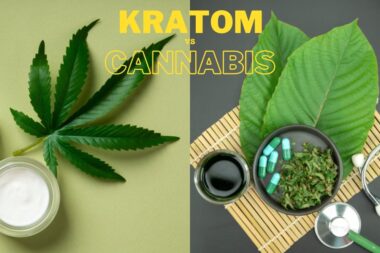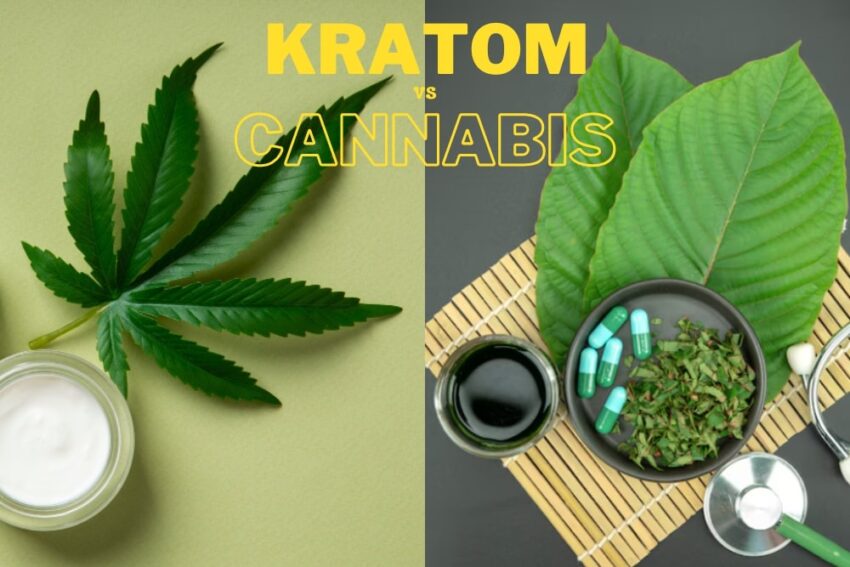In recent years, the domain of natural remedies has experienced significant growth, driven by a collective shift towards alternative medicine and holistic health solutions. Among the most prominent and frequently debated natural remedies are kratom (Mitragyna speciosa) and cannabis (Cannabis sativa). These plants possess unique pharmacological properties and offer a range of potential health benefits that may influence patient care and therapeutic practices.
This article endeavors to provide an in-depth, comparative analysis of the health benefits and uses of kratom and cannabis. This topic is important for health-conscious individuals, patients exploring natural treatment options, and medical professionals interested in integrative medicine.
Understanding Kratom
Kratom (Mitragyna speciosa) is a perennial tree indigenous to the tropical regions of Southeast Asia, including Thailand, Indonesia, Malaysia, and Papua New Guinea. The phytochemical composition of Kratom leaves is notably complex, containing over 40 identified alkaloids.
Among these, mitragynine and 7-hydroxymitragynine have been the focal point of extensive pharmacological research. These two alkaloids are principally responsible for Kratom’s bioactivity, exerting significant effects on the human body through their interactions with a variety of receptors and neural pathways in our brains. The variety of these compounds highlights Kratom’s diverse therapeutic potential, encompassing a variety of potential health benefits.
Historically, Kratom leaves have been used in Southeast Asia for centuries as a traditional medicine. Local communities have utilized Kratom for its stimulant effects at low doses and its analgesic and sedative effects at higher doses. Traditionally, it has been used to combat fatigue, relieve pain, and manage symptoms of various ailments.
Recent studies have highlighted Kratom’s potential in pain management, anxiety relief, and mood enhancement. Research published in the Journal of Medicinal Chemistry suggests that mitragynine and 7-hydroxymitragynine interact with opioid receptors in the brain, providing pain relief without the severe side effects associated with synthetic opioids (Hassan et al., 2013).
Additionally, anecdotal evidence and preliminary clinical studies indicate Kratom’s potential benefits for individuals suffering from anxiety and mood disorders.
Understanding Cannabis
Cannabis, is a plant that has been used for both medicinal and recreational purposes for thousands of years.. The primary active compounds in Cannabis are tetrahydrocannabinol (THC) and cannabidiol (CBD), each contributing to its unique effects.
Historically, Cannabis has been utilized for its psychoactive and therapeutic properties. Ancient civilizations used Cannabis for a variety of medical conditions, including pain relief, digestive issues, and psychological disorders. It has also played a significant role in cultural and religious practices.
In recent years, there has been a surge of interest in Cannabis for its medicinal properties. Current research indicates that Cannabis can be effective in managing chronic pain, reducing inflammation, and alleviating symptoms of anxiety and depression.
According to a study published in the European Journal of Pain, CBD has demonstrated significant potential in pain relief and anti-inflammatory properties without the intoxicating effects of THC (Vučković et al., 2018).
Health Benefits of Kratom vs. Cannabis
1. Pain
Both Kratom and Cannabis have shown promise in pain management, but their mechanisms of action differ. Kratom’s primary alkaloids interact partially with opioid receptors, providing analgesic effects similar to opioids but with a lower risk of respiratory depression and dependency (Hassan et al., 2013).
Conversely, Cannabis has been effective in reducing pain and inflammation through its interaction with our brains very own endocannabinoid system (Vučković et al., 2018).
2. Mental Health
When it comes to mental health, both Kratom and Cannabis offer potential benefits. Kratom is often used for its mood-enhancing and anxiolytic properties. Studies have shown that Kratom can help alleviate symptoms of anxiety and depression, although more clinical trials are needed to fully understand its efficacy and safety (Singh et al., 2016).
On the other hand, Cannabis, especially CBD, has been widely studied for its anxiolytic effects. Research published in Neurotherapeutics indicates that CBD may help reduce anxiety in both clinical and non-clinical populations (Blessing et al., 2015).
3. Addiction and Withdrawal
Both Kratom and Cannabis have been explored as potential aids in addiction recovery. Kratom has been used in Southeast Asia as a traditional remedy for opioid withdrawal, with some studies suggesting it can help reduce withdrawal symptoms and cravings (Singh et al., 2016).
Cannabis, particularly CBD, has also shown promise in reducing cravings and anxiety associated with substance use disorders (Hurd et al., 2015). However, it is important to note the potential for dependency on both substances, which warrants careful consideration and consultation with healthcare professionals.
Risks and Side Effects
While Kratom offers potential health benefits, it also carries risks and side effects. Common side effects include nausea, constipation, dizziness, and drowsiness. There have also been reports of more severe adverse effects, such as liver toxicity and withdrawal symptoms with long-term use (Kruegel & Grundmann, 2018).
Additionally, Kratom’s legal status varies globally, with some countries and states banning its use due to safety concerns.
Cannabis, while generally considered safe for medicinal use, is not without its risks. Potential side effects include dry mouth, dizziness, impaired memory, and anxiety. Long-term use of Cannabis, particularly high-THC strains, can lead to dependency and mental health issues (Volkow et al., 2014).
The legal status of Cannabis also varies, with some regions allowing medical or recreational use, while others maintain strict prohibitions.
Conclusion
When considering Kratom or Cannabis as part of a holistic health regimen, it is essential to weigh the benefits against the risks. Consulting with your health care provider healthcare can help determine the most suitable option based on individual health needs and goals.
Both Kratom and Cannabis may offer potential benefits for pain management, mental health, and addiction recovery, but their safety profiles and legal statuses must also be taken into account when starting a new treatment regime.
The increasing interest in natural and alternative medicine underscores the need for well-researched, balanced information. Kratom and Cannabis each offer unique health benefits and pose specific risks. By making evidence-based choices and consulting healthcare professionals, individuals can navigate the complexities of holistic health with confidence.
References
Hassan, Z., Muzaimi, M., Navaratnam, V., Yusoff, N. H., Suhaimi, F. W., Vadivelu, R., … & Jamil, M. F. (2013). From Kratom to mitragynine and its derivatives: Physiological and behavioural effects related to use, abuse, and addiction. Neuroscience & Biobehavioral Reviews, 37(2), 138-151.
Vučković, S., Srebro, D., Vujović, K. S., Vučetić, Č., & Prostran, M. (2018). Cannabinoids and pain: New insights from old molecules. Frontiers in Pharmacology, 9, 1259.
Singh, D., Müller, C. P., & Vicknasingam, B. K. (2016). Kratom (Mitragyna speciosa) dependence, withdrawal symptoms and craving in regular users. Drug and Alcohol Dependence, 160, 132-137.
Blessing, E. M., Steenkamp, M. M., Manzanares, J., & Marmar, C. R. (2015). Cannabidiol as a potential treatment for anxiety disorders. Neurotherapeutics, 12(4), 825-836.
Hurd, Y. L., Yoon, M., Manini, A. F., Hernandez, S., Olmedo, R., Ostman, M., & Jutras-Aswad, D. (2015). Early phase in the development of cannabidiol as a treatment for addiction: Opioid relapse takes initial center stage. Neurotherapeutics, 12(4), 807-815.
Kruegel, A. C., & Grundmann, O. (2018). The medicinal chemistry and neuropharmacology of Kratom: A preliminary discussion of a promising medicinal plant and analysis of its potential for abuse. Neuropharmacology, 134, 108-120.
Volkow, N. D., Baler, R. D., Compton, W. M., & Weiss, S. R. (2014). Adverse health effects of marijuana use. New England Journal of Medicine, 370(23), 2219-2227.
Image Credit: Freepik

Dr. Paloma Lehfeldt, MD, MA, is a dedicated plant medicine advocate and the Senior Director of Scientific Communications at Levo Naturals. In this role, she leads the company’s scientific education, research partnerships, and community outreach efforts. With over fifteen years of experience in research, community engagement, and education, Dr. Lehfeldt brings a wealth of knowledge and passion to Levo Naturals. Previously, Dr. Lehfeldt served as the Senior Director of Clinical Science and Partnerships at Vireo Health, a physician-founded cannabis company, where she managed Social Equity and Educational Development initiatives. She also chaired Vireo’s Diversity, Equity, and Inclusion Council and was the Chair Emeritus of The National Cannabis Industry Association’s Scientific Advisory Committee.





































Leave a Reply